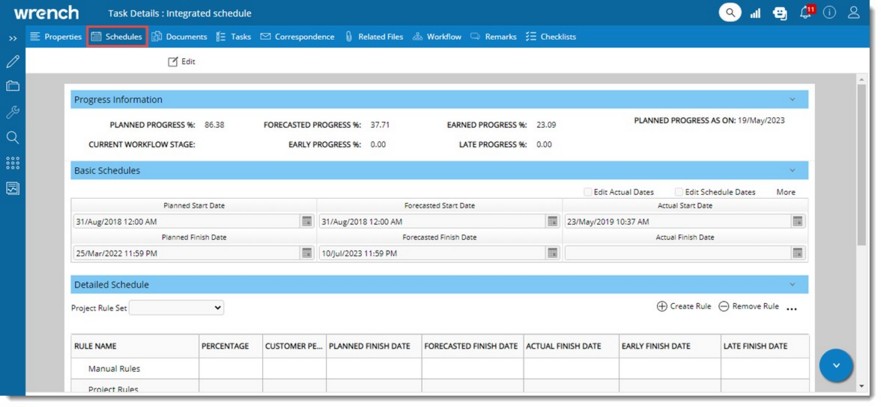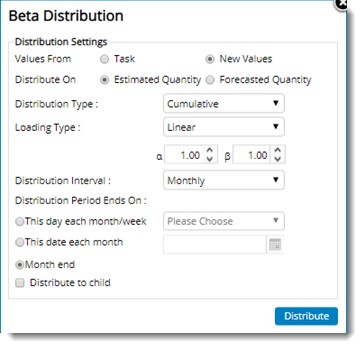The Progress Information area display the current progress and the Planned Progress of the task . If the task is in an active stage of the workflow and there is some planned date assigned to that stage, the information is displayed here.

Planned Progress: The intended progress of the task is displayed here.
Forecasted Progress: Progress that is forecasted for the task is displayed here.
Earned Progress: Total progress achieved by the task is displayed here.
Current Workflow Stage: Current stage of the workflow assigned to the task is displayed here.
Early Progress and Last Progress: This progress is calculated based on Early and Late Start Dates. Progress will be calculated only if these dates are provided.
Planned Progress As On: Planned Progress for the current date is displayed here. On clicking the hyperlink View planned progress as on a different date, Planned Progress As On window is displayed.
NOTE: This hyperlink is displayed only if the setting Allow Planned Progress On Specific Dates is selected in Project Settings.
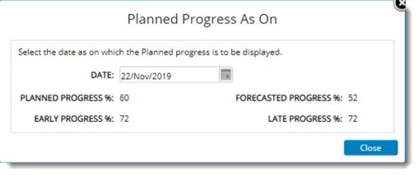
Figure: Planned Progress As On window
Here progress details as on current date is displayed. On selecting a date from the date picker Planned Progress is displayed for the selected date. Progress as on date selected should be greater than Project Start Date.
Most organization use MS Project, Primavera or other scheduling applications to plan their project schedules. These applications will auto calculate the Early and Late dates of activities based on their activity provided in the schedule. By knowing how early an activity can start and how late it will finish will give the planners the flexibility to reallocate resources between other activities that can potentially impact critical path, and hence the project completion date.
Organizations using SmartProject, may import schedule from MS Project or Primavera to WRENCH WBS. While performing the import, they may want to capture Early and Late schedules. Therefore, date fields in task schedule to capture early and late schedules is available. Also, early progress and late progress of the tasks and levels in WBS is displayed.
These dates are described briefly as follows.
Early Start: Earliest date by which an activity can begin.
Early Finish: Earliest date by which an activity can finish.
Late Start: The latest date by which an activity can begin without delaying the project finish date.
Late Finish: The latest date by which an activity must finish without delaying the project finish date.
In the Task Schedules tab, under the option Basic Schedules on clicking the option Show More, option to enter these dates will be available. The dates entered should be between the Project Start Date and End Date.

Figure: Early and Late Dates
In the WBS tree and grid view, the following columns will be available.
- Early Start Date
- Early Finish Date
- Late Start Date
- Late Finish Date
- Early Percentage
- Late Percentage.

These columns will be available in Import and Export templates also.
Detailed schedule details are displayed in this section. This includes information related to rules and their progress. In addition you can carry out the following operations here:
Create and Remove Rule
Update Interim Progress
Micro Scheduling

Figure: Detailed schedule information
Adding rules to a task
Apart from the rule sets defined for a specific project you can add additional rules to a task. Manually added rules can also be removed.
 To add rules to a task
To add rules to a task
- In the Detailed Schedule grid tool bar click Create Rule .
Create Rule window is displayed. The field Rule Name will be populated with a default Rule Name. You can change the default Rule name.
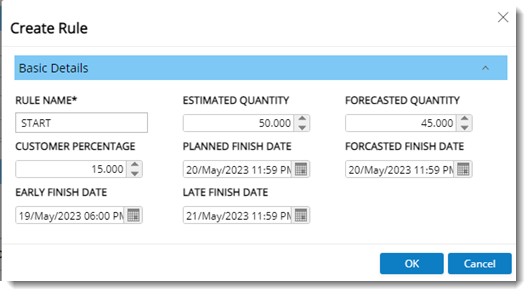
Figure: Create Rule window
- Enter values for different fields in the window and click OK to save changes.
A rule is created and is displayed in the grid.

Figure: Created Rule
 To remove rules
To remove rules
- Select the manual rule which you want to delete.
- In the Detailed Schedule grid tool bar click Remove Rule.
The selected rule is removed.
- Click OK to store changes.
NOTE: If there is no workflow assigned to the task, the percentage information will not be displayed in the area. Only the earned percentage will be displayed.
Filtering rules for quantity tasks
For quantity based tasks, rules can be filtered for both manual and project rules.
To filter rules
- In the more options menu of the Detailed Schedule section, click Filter Rules.

Figure: Filtering rules
Filter Rules window is displayed.
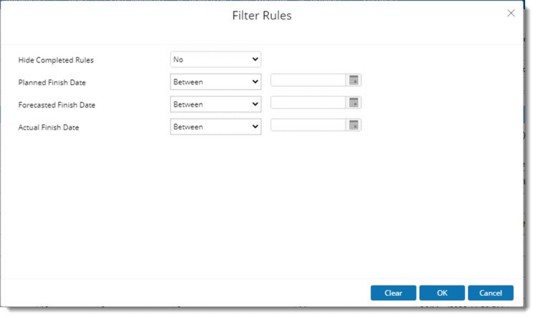
Figure: Filter Rules window
- Enter values for the following criteria.
Hide Completed Rules: Rules with actual finish dates captured can be displayed or hidden. In the drop-down list next to this option, select Yes to display the rules with actual finish dates captured, and select No to hide the rules with actual finish dates captured.
Planned Finish Date: Specify the dates and filter the rules with planned finish dates that fall under the respective criteria.
Forecasted Finish Date: Specify the dates and filter the rules with forecasted finish dates that fall under the respective criteria.
Actual Finish Date: Specify the dates and filter the rules with actual finish dates that fall under the respective criteria.
- After selecting the required operators and specifying values click OK.
The rules matching the criteria are filtered and displayed in the detailed schedule grid.

Figure: Filtered rules
A text, The list below is filtered, indicates that the list displayed is a filtered list.
Filtering upcoming rules
Upcoming rules for a task can also be filtered.
To filter upcoming rules
- In the Filter Rules window select the operator as Within for the Planned finish date or Forecasted finish date.

Figure: Filter Rules window
- In the window specify the number of weeks or months for which the filter needs to be applied.
- Click OK.
The system filters the rules with planned finish dates or forecasted finish dates within the criteria provided. When manual rules are exported to an MS Excel template, only rules displayed in the detailed schedule grid are exported.
Updating Interim Progress
Update Interim Percentage is used to add an interim percentage between the earned percentage and anticipated progress percentage for the next milestone defined in the rule set window. When you achieve one rule of credit and is heading to achieve the next rule of credit stage, you might enter and update the progress percentage in between these rule of credits. An interim stage can be defined as a manual rule to show the percentage completion as to the actual completion date.
 To update interim progress
To update interim progress
- Select the rule for which you want to update interim progress.
- In the Detailed Schedule window, click the link More>>Update Interim Progress.
Update Interim Progress window is displayed.
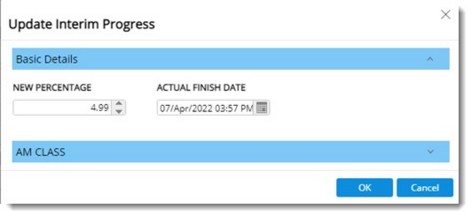
Figure: Updating Interim Progress
- Enter the value for the following fields.
- New Percentage: Enter the new progress percentage for the task. Only a value between the current earned and next milestone can be entered here.
- Actual Finish Date: Select the actual finish date from the date picker.
- Click OK to continue.
NOTE: On updating the progress, if the task's actual start date is blank, the actual start date is updated with the minimum actual finish date specified in the rule assigned to the task.
Updating earned quantity
In the case of construction tasks i.e. tasks with value for the property Progress Captured as equal to Quantity, option to update earned quantity of rule is available.
 To update earned quantity
To update earned quantity
- In the task properties window click Schedules tab.
- In the Detailed Schedule window click More>>Update Earned Quantity.
Update Earned Quantity window is displayed.
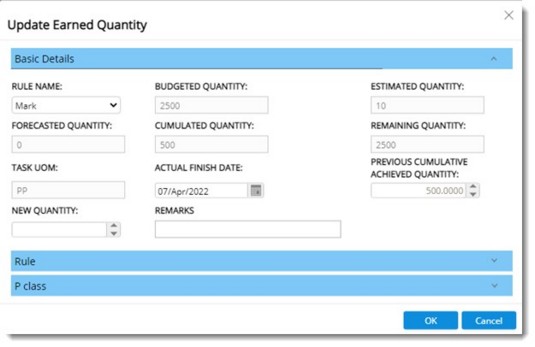
Figure: Update Earned Quantity
- Select the Rule for which quantity has to be updated.
- Select actual finish date.
- In the Project Settings window if the setting Enable Previous Cumulative Achieved Quantity is selected, in the Update Earned Quantity window a field Previous Achieved Cumulative Quantity will be displayed. If Previous Cumulative Quantity is entered after selecting a rule, the entry is saved against the corresponding rule. If a rule is not selected, a manual rule is created with the provided date.
- Enter value for new quantity and Remarks.
- Click OK to update value.
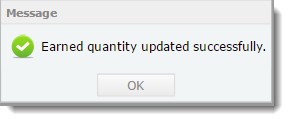
Earned quantity updated successfully window is displayed.
- Click OK to continue.
Updated earned quantity is displayed against the rule as shown in the following figure.

Figure: Earned quantity updated.
Updating earned quantity without selecting a Project or Manual rule
User can update the earned quantity without selecting a project or manual rule.
 To update earned quantity
To update earned quantity
- Click More.. and in the menu click Update Earned Quantity.
Update Earned Quantity window is displayed.
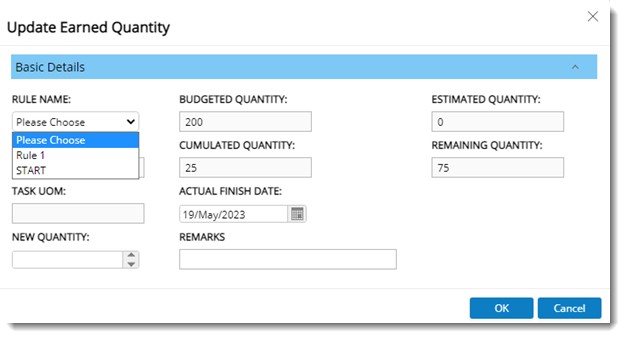
Figure: Update Earned Quantity
- In the window select the rule name from a drop-down list.
- After entering the values click OK.
Once the earned quantity is updated, the rule will be automatically linked under the project or manual rule where the Actual date falls under the planned finish date of the rule.

Figure: Updating earned quantity
NOTE: For manual rule, the updated actual quantity will be added under the corresponding project rule based on planned finish date. On scheduling, if the planned, forecast, early or late start date and Planned forecast, early or late finish date is not specified for quantity-based task, the corresponding dates will be updated automatically from project or manual rules.
Linking and De-linking Actual Rules
If user tries to perform Beta redistribution for quantity-based tasks for which Beta distribution was already performed and user already updated the actuals against a Rule, rectification of errors is not possible.
As a solution to this, facility to link and de-link these child rules (actuals) to and from the parent rules (planned) before Beta redistribution is available.
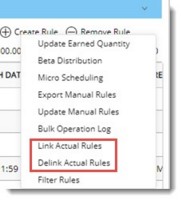
If actuals are entered against a rule and when beta-redistribution is carried out, these actuals (child rules) need to be removed from their parent rules and they need to be added as a separate rule to perform another beta redistribution.
 To remove child rules from parent rules
To remove child rules from parent rules
- In the menu click De-link Actual Rules. The following message is displayed.
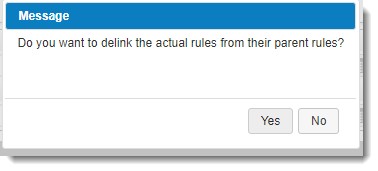
- On clicking Yes, all the actual rules will get de-linked, and a message Actual Rules are de-linked from their plan rules successfully is displayed.
On de-linking, all the child rules (actual rules) are de-linked from their respective parent rules and will exist as a separate parent rule as displayed in below figure.

Figure: Rules after de-linking
The rule before de-linking is shown in the following figure.

Figure: Rules before de-linking
After completing the beta distribution the de-linked rule can be linked back.
 To link the actual rules back to the parent rules
To link the actual rules back to the parent rules
- In the menu click Link Actual Rules. The following warning message is displayed.
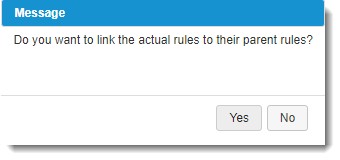
- Click ‘Yes’, to link actual rule back to the parent rule. Click No to cancel the operation.
On clicking Yes, all the actual rules will get linked back to the parent rules, and a message Actual Rules are linked to their plan rules successfully is displayed.
All the ‘actual’ rules which are not linked to a ‘Plan’ rule will get added back to their respective parent rules as a child rule based on the parent rule’s forecasted or planned finish dates and child rule’s actual finish dates.
NOTE: This is also applicable when beta redistribution is performed for estimated quantities where forecasted quantity is already distributed.
Micro scheduling
Here you can specify the duration from one milestone to another, and based on the duration other milestone planned dates can be automatically calculated. Rule of Credit dates are generated automatically based on; a single input, Schedule Start Date, Client Submission Date etc. This process is referred to as Micro Scheduling.
A calendar can be assigned to a milestone based on which the calculation can be carried out. In case a calendar is not assigned calculation is carried out based on the normal Wrench working calendar.
NOTE: Micro Scheduling duration is based on days not on hours.
 To generate rule of credit automatically
To generate rule of credit automatically
- In the Detailed Schedule grid click More>>Micro Scheduling.
Formulate Micro Scheduling window is displayed.
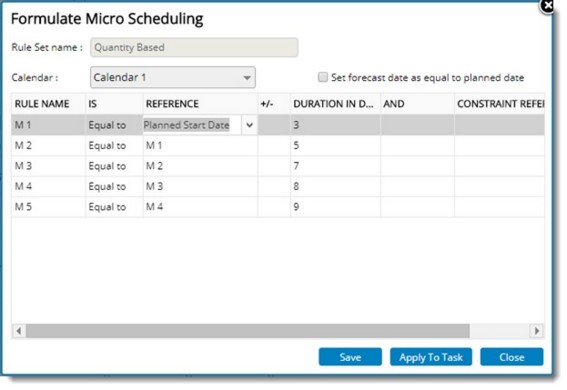
Figure: Micro Scheduling window
In the window the selected Rule set is displayed. The following selections can be made before defining the condition for generating a rule of credit date automatically.
Calendar: Select a calendar from the drop-down list. Calculations are made based on the selected calendar.
Set Forecast Dates as equal to Planned Date: Select the check box if you want to set the forecast dates the same as the planned dates.
- Next step is to define the formula for generating the Rule of Credit dates.
- Specify the Milestone, the Reference milestone, and the Duration in days from the reference milestone . The reference milestone can be Start date, Finish date or any other milestone. The duration could be plus or minus.
For Example: In case the values for calculating rule of credit dates are defined as in the following table.
|
Rule
|
IS
|
Reference
|
+/-
|
Duration in Days
|
|
CHECK
|
equal to
|
Draw
|
+
|
2
|
The dates for activity CHECK will start 2 days after the activity Draw has started. This means if the activity Draw was started on May 25th 2013, then the activity CHECK will start on May 27 th 2013, provided there are no holidays in between.
- Once the formula is defined click Apply.
Dates are updated successfully and the formula is applied to the tasks in WBS.
Select an existing rule set
Click the drop-down arrow next to Project Ruleset. Select the Rules assigned in the project to the task. Existing rule can be only changed for a task in Unscheduled/Scheduled status.



